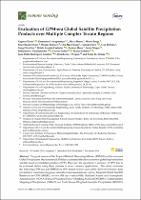Mostrar el registro sencillo del ítem
Evaluation of GPM-era Global Satellite Precipitation Products over Multiple Complex Terrain Regions
| dc.contributor.author | Derin, Y. | |
| dc.contributor.author | Anagnostou, E. | |
| dc.contributor.author | Berne, A. | |
| dc.contributor.author | Borga, M. | |
| dc.contributor.author | Boudevillain, Brice | |
| dc.contributor.author | Buytaert, W. | |
| dc.contributor.author | Chang, Che-Hao | en_US |
| dc.contributor.author | Chen, H. | en_US |
| dc.contributor.author | Delrieu, G | en_US |
| dc.contributor.author | Lavado-Casimiro, W. | en_US |
| dc.contributor.author | Manz, B. | |
| dc.contributor.author | Moges, S. | |
| dc.contributor.author | Nikolopoulos, Efthymios I. | |
| dc.contributor.author | Sahlu, Dejene | |
| dc.contributor.author | Salerno, Franco | |
| dc.contributor.author | Rodríguez-Sánchez, Juan-Pablo | |
| dc.contributor.author | Vergara, Humberto J. | |
| dc.contributor.author | Yilmaz, K.K. | |
| dc.date.accessioned | 2019-07-27T20:07:21Z | |
| dc.date.available | 2019-07-27T20:07:21Z | |
| dc.date.issued | 2019-12-7 | |
| dc.identifier.uri | https://hdl.handle.net/20.500.12542/88 | |
| dc.description.abstract | The great success of the Tropical Rainfall Measuring Mission (TRMM) and its successor Global Precipitation Measurement (GPM) has accelerated the development of global high-resolution satellite-based precipitation products (SPP). However, the quantitative accuracy of SPPs has to be evaluated before using these datasets in water resource applications. This study evaluates the following GPM-era and TRMM-era SPPs based on two years (2014–2015) of reference daily precipitation data from rain gauge networks in ten mountainous regions: Integrated Multi-SatellitE Retrievals for GPM (IMERG, version 05B and version 06B), National Oceanic and Atmospheric Administration (NOAA)/Climate Prediction Center Morphing Method (CMORPH), Global Satellite Mapping of Precipitation (GSMaP), and Multi-Source Weighted-Ensemble Precipitation (MSWEP), which represents a global precipitation data-blending product. The evaluation is performed at daily and annual temporal scales, and at 0.1 deg grid resolution. It is shown that GSMaPV07 surpass the performance of IMERGV06B Final for almost all regions in terms of systematic and random error metrics. The new orographic rainfall classification in the GSMaPV07 algorithm is able to improve the detection of orographic rainfall, the rainfall amounts, and error metrics. Moreover, IMERGV05B showed significantly better performance, capturing the lighter and heavier precipitation values compared to IMERGV06B for almost all regions due to changes conducted to the morphing, where motion vectors are derived using total column water vapor for IMERGV06B. | en_US |
| dc.format | application/pdf | |
| dc.language.iso | eng | en_US |
| dc.publisher | MDPI | en_US |
| dc.relation.ispartof | urn:issn:2072-4292 | |
| dc.rights | info:eu-repo/semantics/openAccess | es_PE |
| dc.rights | Attribution-NonCommercial-ShareAlike 3.0 United States | * |
| dc.rights.uri | http://creativecommons.org/licenses/by-nc-sa/3.0/us/ | * |
| dc.source | Servicio Nacional de Meteorología e Hidrología del Perú | es_PE |
| dc.source | Repositorio Institucional - SENAMHI | es_PE |
| dc.subject | Hidrología | |
| dc.subject | Precipitación | |
| dc.subject | Sistema Solar | |
| dc.subject | Lluvia | en_US |
| dc.title | Evaluation of GPM-era Global Satellite Precipitation Products over Multiple Complex Terrain Regions | en_US |
| dc.type | info:eu-repo/semantics/article | en_US |
| dc.identifier.isni | 0000 0001 0746 0446 | |
| dc.description.peerreview | Por pares | |
| dc.identifier.doi | https://doi.org/10.3390/rs11242936 | |
| dc.identifier.journal | Remote Sensing | |
| dc.source.volume | 2936 | es_PE |
| dc.source.issue | 11 | es_PE |
| dc.source.journal | Remote Sens | es_PE |
| dc.subject.sinia | precipitacion - Clima y Eventos Naturales | |
| dc.type.sinia | text/publicacion cientifica | |
| dc.identifier.url | https://hdl.handle.net/20.500.12542/88 | |
| dc.identifier.url | https://hdl.handle.net/20.500.12542/88 | |
| dc.identifier.url | https://hdl.handle.net/20.500.12542/88 |
Ficheros en el ítem
Este ítem aparece en la(s) siguiente(s) colección(es)
-
Artículo científico [171]









